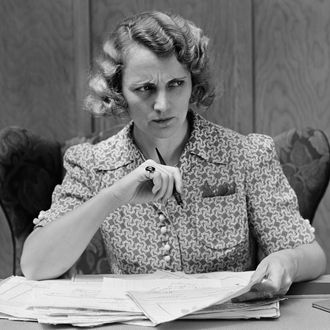
Disorders like anxiety and depression can strike anyone, but women are still twice as likely as men to develop major depression and generalized anxiety. For decades, scientists have tried to explain this difference, citing factors that include hormonal changes that start at puberty, sex differences in stress and coping styles, and various environmental factors. Although all of these things may contribute to the problem, none of them fully explains why women are so much more likely than men to have anxiety or depression.
A new study in Social Science & Medicine has a new hypothesis: Scientists at Columbia University argue that the wage gap between men and women may be a key factor in this disparity. In 1963, women earned 59 cents for every dollar a man earned. By 2013, the gap had closed somewhat, to 82 cents to the dollar. But it still isn’t even, and women with the highest incomes have a larger wage gap than those at the lowest income levels. Pay, of course, is often seen as a stand-in for the value of a person’s work — and, by extension, the value of a person, period. And so the researchers believed that this pay gap contributes to anxiety and depression, by subconsciously making women feel as though they have less value.
Using a subset of data from the National Epidemiologic Survey on Alcohol and Related Conditions, which assesses psychiatric conditions as well as basic demographic and occupational information, the researchers compared income data with lifetime depression and anxiety, as well as the occurrence of these disorders in the past year. Women had just under twice the odds of having major depression in the past year, and more than 2.5 times the odds of generalized anxiety compared to men. Over her lifetime, she had 2.43 times the odds of developing major depression and 4.11 times the odds of developing generalized anxiety compared to men.
But when the researchers compared women who, on average, earned as much or more than their male counterparts, that odds difference disappeared. Both men and women in this group developed anxiety and depression at roughly equal rates. The opposite was also true: Women who earned the lowest compared to men were much more likely to develop anxiety and depression.
Again, the wage gap surely isn’t the only thing that explains the difference in depression rates among men and women, but this new study does add to the urgency of the problem. Someone get Jennifer Lawrence on this.

